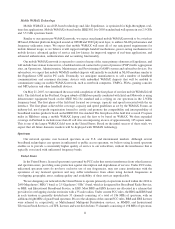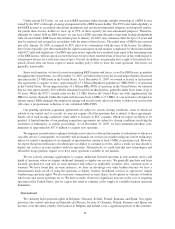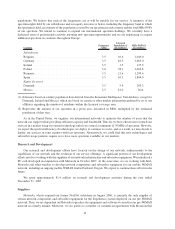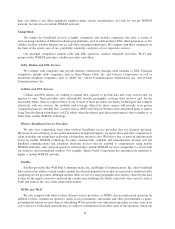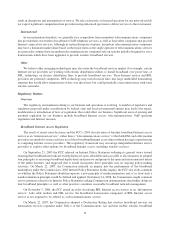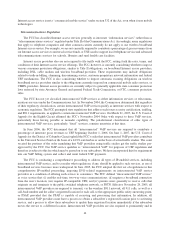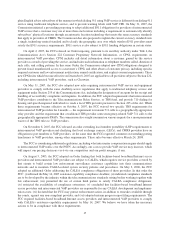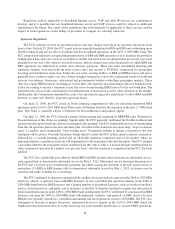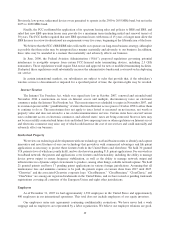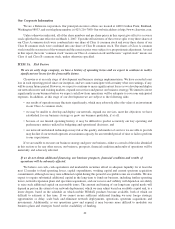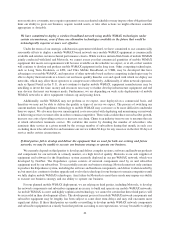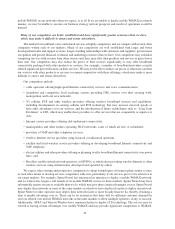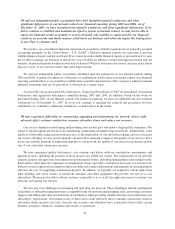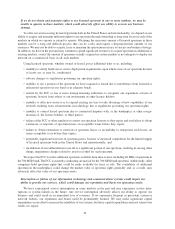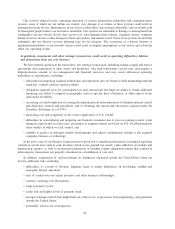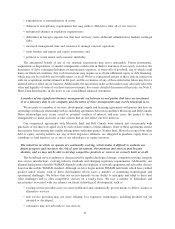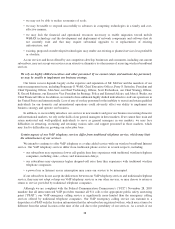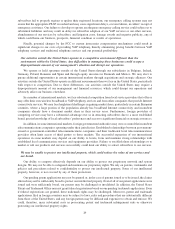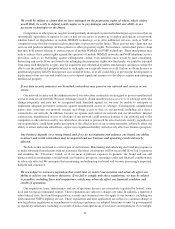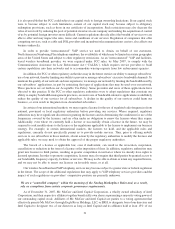Clearwire 2007 Annual Report Download - page 29
Download and view the complete annual report
Please find page 29 of the 2007 Clearwire annual report below. You can navigate through the pages in the report by either clicking on the pages listed below, or by using the keyword search tool below to find specific information within the annual report.We may not be able to secure adequate additional financing when needed on acceptable terms or at all. To raise
additional capital, we may issue additional equity securities in public or private offerings, potentially at a price
lower than the market price of our Class A common stock at the time of such issuance. We will likely seek
significant additional debt financing, in the short-term and the long-term, and, as a result, will likely incur
significant interest expense. Our existing level of debt may make it more difficult for us to obtain this debt financing,
may reduce the amount of money available to finance our operations and other business activities, may expose us to
the risk of increasing interest rates, may make us more vulnerable to general economic downturns and adverse
industry conditions, and may reduce our flexibility in planning for, or responding to, changing business and
economic conditions. We also may decide to sell additional debt or equity securities in our domestic or international
subsidiaries, which may dilute our ownership interest in or reduce or eliminate our income, if any, from those
entities. The recent turmoil in the economy, and the world-wide financial markets in particular, may make it more
difficult for us to obtain necessary additional capital or financing on acceptable terms.
Our substantial indebtedness and restrictive debt covenants could limit our financing options and liquidity
position and may limit our ability to grow our business.
In 2007, we borrowed $1.25 billion under a senior term loan facility. We used a portion of the proceeds to repay
and retire existing loans and secured notes. The remainder of the proceeds will be used for expansion plans,
spectrum acquisition, and general working capital purposes. Our senior term loan facility provides for quarterly
principal payments, with the remaining balance due on the final maturity date. In general, borrowings under the
facility bear interest based, at our option, at either the Euro dollar rate or on an alternate base rate, in each case plus
margin. We also borrowed $10.0 million from BCE Nexxia Corporation, an affiliate of Bell Canada, in June 2006 in
connection with the build-out and deployment of our VoIP infrastructure.
Our substantial indebtedness could have important consequences to the holders of our common stock, such as:
• we may not be able to obtain additional financing to fund working capital, operating losses, capital
expenditures or acquisitions, including spectrum acquisitions, on terms acceptable to us or at all;
• we may be unable to refinance our indebtedness on terms acceptable to us, or at all;
• our substantial indebtedness may make us more vulnerable to economic downturns and limit our ability to
withstand competitive pressures; and
• cash flows from operations and investing activities have been negative since inception and will continue to
be so for some time, and our remaining cash, if any, may be insufficient to operate our business.
Additionally, covenants in the credit agreement governing our term loan facility impose operating and
financial restrictions on us. These restrictions prohibit or limit our ability, and the ability of our subsidiaries, to,
among other things:
• pay dividends to our stockholders;
• incur, or cause certain of our subsidiaries to incur, additional indebtedness;
• permit liens on or conduct sales of any assets pledged as collateral;
• sell all or substantially all of our assets or consolidate or merge with or into other companies;
• repay existing indebtedness; and
• engage in transactions with affiliates.
A breach of any of these covenants could result in a default under our senior term loan facility. If a default
causes our debt repayment obligations to be accelerated, our assets may be insufficient to repay the amount due in
full. If we are unable to repay or refinance those amounts, the collateral agent for our senior term loan facility could
proceed against the assets pledged to secure these obligations, which include substantially all of our assets.
These restrictions may limit our ability to obtain additional financing, withstand downturns in our business and
take advantage of business opportunities. Moreover, we may seek additional debt financing on terms that include
21


